
Culture of Korea
Encyclopedia


North Korea
The Democratic People’s Republic of Korea , , is a country in East Asia, occupying the northern half of the Korean Peninsula. Its capital and largest city is Pyongyang. The Korean Demilitarized Zone serves as the buffer zone between North Korea and South Korea...
and South Korea
South Korea
The Republic of Korea , , is a sovereign state in East Asia, located on the southern portion of the Korean Peninsula. It is neighbored by the People's Republic of China to the west, Japan to the east, North Korea to the north, and the East China Sea and Republic of China to the south...
has resulted in divergence in modern Korean cultures; nevertheless, the traditional culture of Korea is historically shared by both states.
Dance
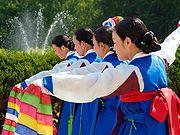
Traditional choreography of court dances is reflected in many contemporary productions.
Painting

Korea
Korea ) is an East Asian geographic region that is currently divided into two separate sovereign states — North Korea and South Korea. Located on the Korean Peninsula, Korea is bordered by the People's Republic of China to the northwest, Russia to the northeast, and is separated from Japan to the...
n peninsula are petroglyph
Petroglyph
Petroglyphs are pictogram and logogram images created by removing part of a rock surface by incising, picking, carving, and abrading. Outside North America, scholars often use terms such as "carving", "engraving", or other descriptions of the technique to refer to such images...
s of prehistoric times. With the arrival of Buddhism
Buddhism
Buddhism is a religion and philosophy encompassing a variety of traditions, beliefs and practices, largely based on teachings attributed to Siddhartha Gautama, commonly known as the Buddha . The Buddha lived and taught in the northeastern Indian subcontinent some time between the 6th and 4th...
from India
India
India , officially the Republic of India , is a country in South Asia. It is the seventh-largest country by geographical area, the second-most populous country with over 1.2 billion people, and the most populous democracy in the world...
via China
China
Chinese civilization may refer to:* China for more general discussion of the country.* Chinese culture* Greater China, the transnational community of ethnic Chinese.* History of China* Sinosphere, the area historically affected by Chinese culture...
, different techniques were introduced. These techniques quickly established themselves as the mainstream techniques, but indigenous techniques still survived.
There is a tendency towards naturalism with subjects such as realistic landscapes, flowers and birds being particularly popular. Ink is the most common material used, and it is painted on mulberry paper or silk
Silk
Silk is a natural protein fiber, some forms of which can be woven into textiles. The best-known type of silk is obtained from the cocoons of the larvae of the mulberry silkworm Bombyx mori reared in captivity...
.
In the 18th century indigenous techniques were advanced, particularly in calligraphy and seal engraving.
Arts are both influenced by tradition and realism in North Korea
North Korea
The Democratic People’s Republic of Korea , , is a country in East Asia, occupying the northern half of the Korean Peninsula. Its capital and largest city is Pyongyang. The Korean Demilitarized Zone serves as the buffer zone between North Korea and South Korea...
. For example, Han’s near-photographic "Break Time at the Ironworks" shows muscular men dripping with sweat and drinking water from tin cups at a sweltering foundry. Jeong Son’s "Peak Chonnyo of Mount Kumgang" is a classical Korean landscape of towering cliffs shrouded by mists.
Crafts

Korea
Korea ) is an East Asian geographic region that is currently divided into two separate sovereign states — North Korea and South Korea. Located on the Korean Peninsula, Korea is bordered by the People's Republic of China to the northwest, Russia to the northeast, and is separated from Japan to the...
. Most of the handicrafts are created for a particular everyday use, often giving priority to the practical use rather than aesthetics
Aesthetics
Aesthetics is a branch of philosophy dealing with the nature of beauty, art, and taste, and with the creation and appreciation of beauty. It is more scientifically defined as the study of sensory or sensori-emotional values, sometimes called judgments of sentiment and taste...
. Traditionally, metal, wood, fabric, lacquerware
Lacquerware
Lacquerware are objects decoratively covered with lacquer. The lacquer is sometimes inlaid or carved. Lacquerware includes boxes, tableware, buttons and even coffins painted with lacquer in cultures mostly in the Eastern Hemisphere.-History:...
, and earthenware
Earthenware
Earthenware is a common ceramic material, which is used extensively for pottery tableware and decorative objects.-Types of earthenware:Although body formulations vary between countries and even between individual makers, a generic composition is 25% ball clay, 28% kaolin, 32% quartz, and 15%...
were the main materials used, but later glass, leather or paper have sporadically been used.
Ancient handicrafts, such as red and black pottery, share similarities with pottery of Chinese
China
Chinese civilization may refer to:* China for more general discussion of the country.* Chinese culture* Greater China, the transnational community of ethnic Chinese.* History of China* Sinosphere, the area historically affected by Chinese culture...
cultures along the Yellow River
Yellow River
The Yellow River or Huang He, formerly known as the Hwang Ho, is the second-longest river in China and the sixth-longest in the world at the estimated length of . Originating in the Bayan Har Mountains in Qinghai Province in western China, it flows through nine provinces of China and empties into...
. The relics found of the Bronze Age
Bronze Age
The Bronze Age is a period characterized by the use of copper and its alloy bronze as the chief hard materials in the manufacture of some implements and weapons. Chronologically, it stands between the Stone Age and Iron Age...
, however, are distinctive and more elaborate.
Many sophisticated and elaborate handicrafts have been excavated, including gilt crowns, patterned pottery, pots or ornaments. During the Goryeo period the use of bronze was advanced. Brass
Brass
Brass is an alloy of copper and zinc; the proportions of zinc and copper can be varied to create a range of brasses with varying properties.In comparison, bronze is principally an alloy of copper and tin...
, that is copper
Copper
Copper is a chemical element with the symbol Cu and atomic number 29. It is a ductile metal with very high thermal and electrical conductivity. Pure copper is soft and malleable; an exposed surface has a reddish-orange tarnish...
with one third zinc
Zinc
Zinc , or spelter , is a metallic chemical element; it has the symbol Zn and atomic number 30. It is the first element in group 12 of the periodic table. Zinc is, in some respects, chemically similar to magnesium, because its ion is of similar size and its only common oxidation state is +2...
, has been a particularly popular material. The dynasty, however, is renowned for its use of celadon
Celadon
Celadon is a term for ceramics denoting both a type of glaze and a ware of a specific color, also called celadon. This type of ware was invented in ancient China, such as in the Zhejiang province...
ware.
During the Joseon period popular handicrafts were made of porcelain and decorated with blue painting. Woodcraft was also advanced during that period. This led to more sophisticated pieces of furniture, including wardrobes, chests, tables or drawers.
Ceramics

Earthenware
Earthenware is a common ceramic material, which is used extensively for pottery tableware and decorative objects.-Types of earthenware:Although body formulations vary between countries and even between individual makers, a generic composition is 25% ball clay, 28% kaolin, 32% quartz, and 15%...
on the Korean peninsula goes back to the Neolithic
Neolithic
The Neolithic Age, Era, or Period, or New Stone Age, was a period in the development of human technology, beginning about 9500 BC in some parts of the Middle East, and later in other parts of the world. It is traditionally considered as the last part of the Stone Age...
. The history of Korean Ceramics is long and includes both Korean pottery a later development after the traditional use of coils and hammered clay to create early votive and sculptural artifacts. During the Three Kingdoms period, pottery was advanced in Silla
Silla
Silla was one of the Three Kingdoms of Korea, and one of the longest sustained dynasties in...
. The pottery
Pottery
Pottery is the material from which the potteryware is made, of which major types include earthenware, stoneware and porcelain. The place where such wares are made is also called a pottery . Pottery also refers to the art or craft of the potter or the manufacture of pottery...
was fired using a deoxidizing flame, which caused the distinctive blue grey celadon color. The surface was embossed with various geometrical patterns.
In the Goryeo period jade green celadon ware became more popular. In the 12th century sophisticated methods of inlaying were invented, allowing more elaborate decorations in different colours. In Arts of Korea, Evelyn McCune states, "During the twelfth century, the production of ceramic ware reached its highest refinement. Several new varieties appeared simultaneously in the quarter of a century, one of which, the inlaid ware must be considered a Korean invention." Neither the Chinese nor the Japanese had produced inlaid celadon, which was unique to Goryeo wares. William Bowyer Honey of the Victoria and Albert Museum of England, who after World War II wrote, "The best Corean (Korean) wares were not only original, they are the most gracious and unaffected pottery ever made. They have every virtue that pottery can have. This Corean pottery, in fact, reached heights hardly attained even by the Chinese."
White porcelain
Porcelain
Porcelain is a ceramic material made by heating raw materials, generally including clay in the form of kaolin, in a kiln to temperatures between and...
became popular in the 15th century. It soon overtook celadon ware. White porcelain was commonly painted or decorated with copper.
During the Imjin wars in the 16th century, many potters were abducted to Japan
Japan
Japan is an island nation in East Asia. Located in the Pacific Ocean, it lies to the east of the Sea of Japan, China, North Korea, South Korea and Russia, stretching from the Sea of Okhotsk in the north to the East China Sea and Taiwan in the south...
where they heavily influenced Japanese ceramics.
Many Japanese pottery families today can trace their art and ancestry to these Korean potters whom the Japanese captured by the thousands during its repeated conquests of the Korean peninsula.
In the late Joseon period (late 17th century) blue-and-white porcelain became popular. Designs were painted in cobalt blue on white porcelain.
Homes
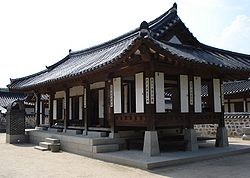
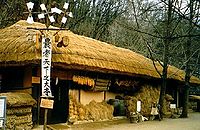
Geomancy
Geomancy is a method of divination that interprets markings on the ground or the patterns formed by tossed handfuls of soil, rocks, or sand...
. Although geomancy had been a vital part of Korean culture and Korean Shamanism
Korean shamanism
Korean shamanism, today known as Muism or sometimes Sinism , encompasses a variety of indigenous religious beliefs and practices of the Korean people and the Korean area...
since prehistoric times, geomancy was later re-introduced by China during the Three Kingdoms period of Korea.
A house should be built against a hill and face south to receive as much sunlight as possible. This orientation is still preferred in modern Korea. Geomancy also influences the shape of the building, the direction it faces and the material it is built of.
Traditional Korean houses can be structured into an inner wing (안채, anchae) and an outer wing (사랑채, sarangchae). The individual layout largely depends on the region and the wealth of the family. Whereas aristocrats used the outer wing for receptions, poorer people kept cattle in the sarangchae. The wealthier a family, the larger the house. However, it was forbidden to any family except for the king to have a residence of more than 99 kan. A kan is the distance between two pillars used in traditional houses.
The inner wing normally consisted of a living room, a kitchen and a wooden-floored central hall. More rooms may be attached to this. Poorer farmers would not have any outer wing. Floor heating (온돌, ondol
Ondol
An ondol, also called gudeul, in Korean traditional architecture, is underfloor heating which uses direct heat transfer from wood smoke to the underside of a thick masonry floor...
) has been used in Korea since prehistoric times. The main building materials are wood
Wood
Wood is a hard, fibrous tissue found in many trees. It has been used for hundreds of thousands of years for both fuel and as a construction material. It is an organic material, a natural composite of cellulose fibers embedded in a matrix of lignin which resists compression...
, clay
Clay
Clay is a general term including many combinations of one or more clay minerals with traces of metal oxides and organic matter. Geologic clay deposits are mostly composed of phyllosilicate minerals containing variable amounts of water trapped in the mineral structure.- Formation :Clay minerals...
, tile
Tile
A tile is a manufactured piece of hard-wearing material such as ceramic, stone, metal, or even glass. Tiles are generally used for covering roofs, floors, walls, showers, or other objects such as tabletops...
, stone
Rock (geology)
In geology, rock or stone is a naturally occurring solid aggregate of minerals and/or mineraloids.The Earth's outer solid layer, the lithosphere, is made of rock. In general rocks are of three types, namely, igneous, sedimentary, and metamorphic...
, and thatch
Thatching
Thatching is the craft of building a roof with dry vegetation such as straw, water reed, sedge , rushes, or heather, layering the vegetation so as to shed water away from the inner roof. It is a very old roofing method and has been used in both tropical and temperate climates...
. Because wood and clay were the most common materials used in the past not many old buildings have survived into present times. Today, however, people live in apartments and more modernized houses.
Gardens
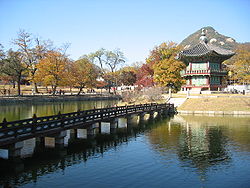
East Asia
East Asia or Eastern Asia is a subregion of Asia that can be defined in either geographical or cultural terms...
is influenced by primarily Korean Shamanism
Korean shamanism
Korean shamanism, today known as Muism or sometimes Sinism , encompasses a variety of indigenous religious beliefs and practices of the Korean people and the Korean area...
and Korean folk religion. Shamanism emphasizes nature and mystery, paying great attention to the details of the layout. In contrast to Japanese and Chinese gardens which fill a garden with man made elements, traditional Korean gardens avoid artificialities, trying to make a garden more natural than nature.
The lotus
Nelumbo nucifera
Nelumbo nucifera, known by a number of names including Indian Lotus, Sacred Lotus, Bean of India, or simply Lotus, is a plant in the monogeneric family Nelumbonaceae...
pond is an important feature in the Korean garden. If there is a natural stream, often a pavilion is built next to it, allowing the pleasure of watching the water
Water
Water is a chemical substance with the chemical formula H2O. A water molecule contains one oxygen and two hydrogen atoms connected by covalent bonds. Water is a liquid at ambient conditions, but it often co-exists on Earth with its solid state, ice, and gaseous state . Water also exists in a...
. Terraced flower beds are a common feature in traditional Korea
Korea
Korea ) is an East Asian geographic region that is currently divided into two separate sovereign states — North Korea and South Korea. Located on the Korean Peninsula, Korea is bordered by the People's Republic of China to the northwest, Russia to the northeast, and is separated from Japan to the...
n gardens.
The Poseokjeong site near Gyeongju
Gyeongju
Gyeongju is a coastal city in the far southeastern corner of North Gyeongsang province in South Korea. It is the second largest city by area in the province after Andong, covering with a population of 269,343 people according to the 2008 census. Gyeongju is southeast of Seoul, and east of the...
was built in the Silla
Silla
Silla was one of the Three Kingdoms of Korea, and one of the longest sustained dynasties in...
period. It highlights the importance of water in traditional Korean gardens. The garden of Poseokjeong features an abalone-shaped watercourse. During the last days of the Silla
Silla
Silla was one of the Three Kingdoms of Korea, and one of the longest sustained dynasties in...
kingdom, the king's guests would sit along the watercourse and chat while wine cups were floated during banquets.
Clothing
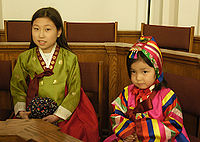
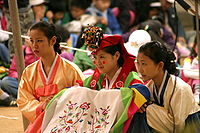
North Korea
The Democratic People’s Republic of Korea , , is a country in East Asia, occupying the northern half of the Korean Peninsula. Its capital and largest city is Pyongyang. The Korean Demilitarized Zone serves as the buffer zone between North Korea and South Korea...
) has been worn since ancient times. The hanbok consists of a shirt (jeogori) and a skirt (baji). The traditional hat is called gwanmo and special meaning is attached to this piece of clothing.
According to social status, Koreans used to dress differently, making clothing an important mark of social rank. Impressive, but sometimes cumbersome, costumes were worn by the ruling class and the royal family. These upper classes also used jewelry to distance themselves from the ordinary people. A traditional item of jewelry for women was a pendant in the shape of certain elements of nature which was made of precious gemstones, to which a tassel of silk was connected.
Common people were often restricted to un-dyed plain clothes. This everyday dress underwent relatively few changes during the Joseon period. The basic everyday dress was shared by everyone, but distinctions were drawn in official and ceremonial clothes.
During the winter people wore cotton-wadded dresses. Fur was also common. Because ordinary people normally wore pure white undyed materials, the people were sometimes referred to as the white-clad people.
Hanbok are classified according to their purposes: everyday dress, ceremonial dress and special dress. Ceremonial dresses are worn on formal occasions, including a child's first birthday (doljanchi
Doljanchi
Dol or doljanchi is a Korean tradition that celebrates the birthday of a one-year-old baby. This ceremony blesses the child with a prosperous future and has taken on great significance in Korea...
), a wedding or a funeral. Special dresses are made for purposes such as shamans, officials.
Today the hanbok is still worn during formal occasions. The everyday use of the dress, however, has been lost. However, elderly still dress in hanbok as well as active estates of the remnant of aristocratic families from the Joseon Dynasty.
Cuisine
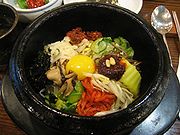
Rice
Rice is the seed of the monocot plants Oryza sativa or Oryza glaberrima . As a cereal grain, it is the most important staple food for a large part of the world's human population, especially in East Asia, Southeast Asia, South Asia, the Middle East, and the West Indies...
is the staple food
Staple food
A staple food is one that is eaten regularly and in such quantities that it constitutes a dominant portion of a diet, and that supplies a high proportion of energy and nutrient needs. Most people live on a diet based on one or more staples...
of Korea. Having been an almost exclusively agricultural country until recently, the essential recipes in Korea are shaped by this experience. The main crops in Korea are rice, barley
Barley
Barley is a major cereal grain, a member of the grass family. It serves as a major animal fodder, as a base malt for beer and certain distilled beverages, and as a component of various health foods...
, and bean
Bean
Bean is a common name for large plant seeds of several genera of the family Fabaceae used for human food or animal feed....
s, but many supplementary crops are used. Fish
Fish
Fish are a paraphyletic group of organisms that consist of all gill-bearing aquatic vertebrate animals that lack limbs with digits. Included in this definition are the living hagfish, lampreys, and cartilaginous and bony fish, as well as various extinct related groups...
and other seafood
Seafood
Seafood is any form of marine life regarded as food by humans. Seafoods include fish, molluscs , crustaceans , echinoderms . Edible sea plants, such as some seaweeds and microalgae, are also seafood, and are widely eaten around the world, especially in Asia...
are also important because Korea is a peninsula.
Fermented
Fermentation (food)
Fermentation in food processing typically is the conversion of carbohydrates to alcohols and carbon dioxide or organic acids using yeasts, bacteria, or a combination thereof, under anaerobic conditions. Fermentation in simple terms is the chemical conversion of sugars into ethanol...
recipes were also developed in early times. These include pickled
Pickling
Pickling, also known as brining or corning is the process of preserving food by anaerobic fermentation in brine to produce lactic acid, or marinating and storing it in an acid solution, usually vinegar . The resulting food is called a pickle. This procedure gives the food a salty or sour taste...
fish and pickled vegetables. This kind of food provides essential protein
Protein
Proteins are biochemical compounds consisting of one or more polypeptides typically folded into a globular or fibrous form, facilitating a biological function. A polypeptide is a single linear polymer chain of amino acids bonded together by peptide bonds between the carboxyl and amino groups of...
s and vitamin
Vitamin
A vitamin is an organic compound required as a nutrient in tiny amounts by an organism. In other words, an organic chemical compound is called a vitamin when it cannot be synthesized in sufficient quantities by an organism, and must be obtained from the diet. Thus, the term is conditional both on...
s during the winter.
A number of menus have been developed. These can be divided into ceremonial foods and ritual foods. Ceremonial foods are used when a child reaches 100 days, at the first birthday, at a wedding ceremony, and the sixtienth birthday. Ritual foods are used at funerals, at ancestral rites, shaman's offerings and as temple food.
A distinguishing characteristic of Temple Food is that it does not use the common five strong-flavoured ingredients of Korean cuisine--(garlic
Garlic
Allium sativum, commonly known as garlic, is a species in the onion genus, Allium. Its close relatives include the onion, shallot, leek, chive, and rakkyo. Dating back over 6,000 years, garlic is native to central Asia, and has long been a staple in the Mediterranean region, as well as a frequent...
, spring onion
Scallion
Scallions , are the edible plants of various Allium species, all of which are "onion-like", having hollow green leaves and lacking a fully developed root bulb.-Etymology:The words...
, wild rocambole
Rocambole
Rocambole may be* A name of two kinds of garlic, Allium scorodoprasum and Allium ascalonium, the latter of which is also called shallot...
, leek
Leek
The leek, Allium ampeloprasum var. porrum , also sometimes known as Allium porrum, is a vegetable which belongs, along with the onion and garlic, to family Amaryllidaceae, subfamily Allioideae...
, and ginger
Ginger
Ginger is the rhizome of the plant Zingiber officinale, consumed as a delicacy, medicine, or spice. It lends its name to its genus and family . Other notable members of this plant family are turmeric, cardamom, and galangal....
), and meat.
Kimchi is one of the famous foods of Korea. Kimchi is pickled vegetables which contain vitamins A and C, thiamine, riboflavin, iron, calcium, carotene, etc. There are many types of kimchi including cabbage kimchi, string onion kimchi, cucumber kimchi, radish kimchi, and sesame kimchi.
For ceremonies and rituals rice cake
Rice cake
A rice cake may be any kind of food item made from rice that has been shaped, condensed, or otherwise combined into a single object. A wide variety of rice cakes exist in many different cultures in which rice is eaten, and are particularly prevalent in Asia. The origin of rice cake seems to be...
s are vital. The colouring of the food and the ingredients of the recipes are matched with a balance of yin and yang
Yin and yang
In Asian philosophy, the concept of yin yang , which is often referred to in the West as "yin and yang", is used to describe how polar opposites or seemingly contrary forces are interconnected and interdependent in the natural world, and how they give rise to each other in turn. Opposites thus only...
.
Today, surasang
Korean royal court cuisine
Korean royal court cuisine was the style of cookery within Korean cuisine traditionally consumed at the court of the Joseon Dynasty, which ruled Korea from 1392 to 1910. There has been a revival of this cookery style in the 21st century...
(traditional court
Noble court
The court of a monarch, or at some periods an important nobleman, is a term for the extended household and all those who regularly attended on the ruler or central figure...
cuisine) is available to the whole population. In the past vegetable dishes were essential, but meat consumption has increased. Traditional dishes include ssam
Ssam
Ssam, literally meaning "wrapped," refers to a dish in Korean cuisine in which usually leaf vegetables are used to wrap a piece of meat such as pork...
bap, bulgogi
Bulgogi
Bulgogi is a Korean dish that usually consists of marinated barbecued beef, although chicken or pork may also be used. It is listed at number 23 on World's 50 most delicious foods readers' poll complied by CNN Go in 2011.-Etymology:...
, sinseollo
Sinseollo
Sinseollo or yeolguja tang is an elaborate dish consisting of meatballs, small and round jeonyueo , mushrooms, and vegetables cooked in a rich broth in Korean royal court cuisine. The dish is a form of jeongol...
, kimchi
Kimchi
Kimchi , also spelled gimchi, kimchee, or kim chee, is a traditional fermented Korean dish made of vegetables with varied seasonings. There are hundreds of varieties of kimchi made with a main vegetable ingredient such as napa cabbage, radish, green onions or cucumber. It is the most common...
, bibimbap
Bibimbap
Bibimbap is a signature Korean dish. The word literally means "mixed meal." Bibimbap is served as a bowl of warm white rice topped with namul and gochujang . A raw or fried egg and sliced meat are common additions. The ingredients are stirred together thoroughly just before eating...
, and gujeolpan
Gujeolpan
Gujeolpan refers to either an elaborate Korean dish consisting of nine different foods assorted on a wooden plate with nine divided sections in an octagon shape or the plate itself. The name is composed of three hanja words: gu , jeol , and pan in Korean...
.
Tea

Korea
Korea ) is an East Asian geographic region that is currently divided into two separate sovereign states — North Korea and South Korea. Located on the Korean Peninsula, Korea is bordered by the People's Republic of China to the northwest, Russia to the northeast, and is separated from Japan to the...
dates back over 2000 years and was imported from China. It was part of a number of worship recipes, hoping that the good scents would reach the heavenly gods. Although the origin of tea is obscure, tea was introduced in Korea, and later gave rise to the Korean tea ceremony
Korean tea ceremony
The Korean tea ceremony or darye is a traditional form of tea ceremony practiced in Korea. Darye literally refers to "etiquette for tea" or "day tea rite" and has been kept among Korean people for a few thousand years...
, of which Korea has over 3000.
Originally tea was used for ceremonial purposes or as part of traditional herbal medicine
Medicine
Medicine is the science and art of healing. It encompasses a variety of health care practices evolved to maintain and restore health by the prevention and treatment of illness....
.Some of teas made of fruits, leaves, seeds or roots are enjoyed. Five tastes of tea are distinguished in Korea: sweet, sour, salty, bitter, and pungent.
Festivals of the lunar calendar
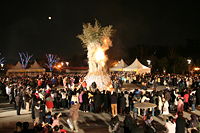
Korean calendar
The traditional Korean calendar is a lunisolar calendar, like the traditional calendars of other East Asian countries. Dates are calculated from Korea's meridian, and observances and festivals are based in Korean culture....
was based on the lunisolar calendar
Lunisolar calendar
A lunisolar calendar is a calendar in many cultures whose date indicates both the moon phase and the time of the solar year. If the solar year is defined as a tropical year then a lunisolar calendar will give an indication of the season; if it is taken as a sidereal year then the calendar will...
. Dates are calculated from Korea's meridian
Meridian (geography)
A meridian is an imaginary line on the Earth's surface from the North Pole to the South Pole that connects all locations along it with a given longitude. The position of a point along the meridian is given by its latitude. Each meridian is perpendicular to all circles of latitude...
, and observances and festivals are rooted in Korean culture. The Korean lunar calendar
Korean calendar
The traditional Korean calendar is a lunisolar calendar, like the traditional calendars of other East Asian countries. Dates are calculated from Korea's meridian, and observances and festivals are based in Korean culture....
is divided into 24 turning points (절기, jeolgi), each lasting about 15 days. The lunar calendar was the timetable for the agrarian society in the past, but is vanishing in the modern Korean lifestyle.
The Gregorian calendar
Gregorian calendar
The Gregorian calendar, also known as the Western calendar, or Christian calendar, is the internationally accepted civil calendar. It was introduced by Pope Gregory XIII, after whom the calendar was named, by a decree signed on 24 February 1582, a papal bull known by its opening words Inter...
was officially adopted in 1895, but traditional holidays and age reckoning
East Asian age reckoning
East Asian age reckoning is a concept and practice that originated in China and is widely used by other cultures in East Asia, which share this traditional way of counting a person's age. Newborns start at one year old, and each passing of a Lunar New Year, rather than the birthday, adds one year...
are still based on the old calendar. Older generations still celebrate their birthdays according to the lunar calendar.
The biggest festival in Korea today is Seollal (the traditional Korean New Year
Korean New Year
Korean New Year, commonly known as Seollal , is the first day of the lunar calendar. It is the most important of the traditional Korean holidays. It consists of a period of celebrations, starting on New Year's Day. Koreans also celebrate solar New Year's Day on January 1 each year, following the...
). Other important festivals include Daeboreum
Daeboreum
Daeboreum is a Korean holiday that celebrates the first full moon of the new year of the lunar Korean calendar. This holiday is accompanied by many traditions.-Traditions:One familiar custom is to crack nuts with one's teeth...
(the first full moon), Dano (spring festival), and Chuseok
Chuseok
Chuseok , originally known as Hangawi , is a major harvest festival and a three-day holiday in Korea celebrated on the 15th day of the 8th month of the lunar calendar. Like many other harvest festivals, it is held around the Autumn Equinox...
(harvest festival).
There are also a number of regional festivals, celebrated according to the lunar calendar. See also Public holidays in North Korea
Public holidays in North Korea
This is a list of Public holidays in North Korea. See also the Korean calendar for a list of traditional holidays....
and Public holidays in South Korea
Public holidays in South Korea
Public holidays in South Korea each belong to one or more of three categories:*National Celebration Day *National Flag Raising Day *Public Day Off...
.
Games
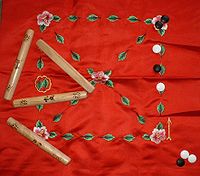
Chess
Chess is a two-player board game played on a chessboard, a square-checkered board with 64 squares arranged in an eight-by-eight grid. It is one of the world's most popular games, played by millions of people worldwide at home, in clubs, online, by correspondence, and in tournaments.Each player...
in Western cultures. There is a Korean version of chess called Janggi
Janggi
Janggi , sometimes called Korean chess, is a strategic board game popular in Korea. It derived from Xiangqi , which itself is thought to be a descendent of the Indian chess game Chaturanga...
, based on an old version of Xiangqi
Xiangqi
Xiangqi is a two-player Chinese board game in the same family as Western chess, chaturanga, shogi, Indian chess and janggi. The present-day form of Xiangqi originated in China and is therefore commonly called Chinese chess in English. Xiangqi is one of the most popular board games in China...
. Yut
Yut
Yut Nori is a traditional board game played in Korea, especially during Korean New Year. The game is also called cheok-sa or sa-hee...
is a popular family board game enjoyed throughout the country, especially during holidays.
No longer commonly played, except on special occasions, Chajeon Nori
Chajeon Nori
Chajeon Nori, occasionally translated as Juggernaut Battle, is a traditional Korean game usually played by men, originating in the Andong region. It may have originated as a commemoration of Wang Geon's victory over Gyeon Hwon at the Battle of Gochang in 935, near the end of the Later Three...
is a traditional game involving two teams of villagers in a giant jousting match.
Many folk games are associated with shamanistic rites and have been handed down from one generation to the next. Three rites are important with regards to folk games: Yeonggo, Dongmaeng and Mucheon. Yeonggo is a drumming performance to invoke spirits. Dongmaeng is a harvest ceremony, while Mucheon is dances to the heaven. These performances were refined during the period of the Three Kingdoms and games were added.
Ssireum
Ssireum
Historically, there have been other terms for "wrestling" in Korean used alongside ssireum, such as gakjeo , gakhui , gakryeok , gakgii , chiuhui , sangbak , jaenggyo ....
is a form of traditional wrestling. Other traditional games include pitching arrows into a pot, tuho and a game of stick-tossing (jeopo). There are also stone fights (seokjeon), swing riding (geunetagi), masked dance drama, and a ball game (gyeokku).
Beliefs
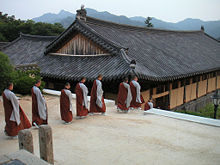
Shamanism
Shamanism is an anthropological term referencing a range of beliefs and practices regarding communication with the spiritual world. To quote Eliade: "A first definition of this complex phenomenon, and perhaps the least hazardous, will be: shamanism = technique of ecstasy." Shamanism encompasses the...
, which though not as widespread as in ancient times, still survives to this day. Female shamans or mudang are often called upon to enlist the help of various spirits to achieve various means.
Buddhism
Buddhism
Buddhism is a religion and philosophy encompassing a variety of traditions, beliefs and practices, largely based on teachings attributed to Siddhartha Gautama, commonly known as the Buddha . The Buddha lived and taught in the northeastern Indian subcontinent some time between the 6th and 4th...
and Confucianism
Confucianism
Confucianism is a Chinese ethical and philosophical system developed from the teachings of the Chinese philosopher Confucius . Confucianism originated as an "ethical-sociopolitical teaching" during the Spring and Autumn Period, but later developed metaphysical and cosmological elements in the Han...
were later introduced to Korea through cultural exchanges with Chinese dynasties. Buddhism was the official religion of the Goryeo dynasty, and many privileges were given to Buddhist monks during this period. However, the Joseon period saw the suppression of Buddhism, where Buddhist monks and temples were banned from the cities and confined to the countryside. In its place a strict form of Confucianism
Korean Confucianism
Korean Confucianism is the form of Confucianism developed in Korea. One of the most substantial influences in Korean intellectual history was the introduction of Confucian thought as part of the cultural influence from China...
, which some see as even more strict than what had ever been adopted by the Chinese, became the official philosophy.
Even today, Confucianism still plays a major role in Korean society, and respect for elders is still a major part of Korean family life. Throughout Korean history and culture, regardless of separation, the traditional beliefs of Korean Shamanism
Korean shamanism
Korean shamanism, today known as Muism or sometimes Sinism , encompasses a variety of indigenous religious beliefs and practices of the Korean people and the Korean area...
, Mahayana Buddhism and Confucianism
Confucianism
Confucianism is a Chinese ethical and philosophical system developed from the teachings of the Chinese philosopher Confucius . Confucianism originated as an "ethical-sociopolitical teaching" during the Spring and Autumn Period, but later developed metaphysical and cosmological elements in the Han...
have remained an underlying influence of the religion of the Korean people as well as a vital aspect of their culture, remembering that all these traditions coexisted peacefully for hundreds of years that still exist in the more Christian South or the pressure from Communism
Communism
Communism is a social, political and economic ideology that aims at the establishment of a classless, moneyless, revolutionary and stateless socialist society structured upon common ownership of the means of production...
's atheist government
Government of North Korea
The North Korean government is the executive branch of the state, according to the Constitution of North Korea. In practice, the highest decisions are made by the National Defence Commission of North Korea which is led by its Chairman Kim Jong-il....
in the North.
World Heritage sites
There are a number of designated UNESCOUNESCO
The United Nations Educational, Scientific and Cultural Organization is a specialized agency of the United Nations...
World Heritage Site
World Heritage Site
A UNESCO World Heritage Site is a place that is listed by the UNESCO as of special cultural or physical significance...
s in Korea
Korea
Korea ) is an East Asian geographic region that is currently divided into two separate sovereign states — North Korea and South Korea. Located on the Korean Peninsula, Korea is bordered by the People's Republic of China to the northwest, Russia to the northeast, and is separated from Japan to the...
.
Jongmyo Shrine
The Jongmyo Shrine was added to the UNESCOUNESCO
The United Nations Educational, Scientific and Cultural Organization is a specialized agency of the United Nations...
World Heritage Site
World Heritage Site
A UNESCO World Heritage Site is a place that is listed by the UNESCO as of special cultural or physical significance...
list in 1995 and is located in Seoul. The shrine is dedicated to the spirits of the ancestors of the royal family of the Joseon Dynasty
Joseon Dynasty
Joseon , was a Korean state founded by Taejo Yi Seong-gye that lasted for approximately five centuries. It was founded in the aftermath of the overthrow of the Goryeo at what is today the city of Kaesong. Early on, Korea was retitled and the capital was relocated to modern-day Seoul...
. It is heavily influenced by Korean Confucian
Korean Confucianism
Korean Confucianism is the form of Confucianism developed in Korea. One of the most substantial influences in Korean intellectual history was the introduction of Confucian thought as part of the cultural influence from China...
tradition. An elaborate performance of ancient court music
Korean court music
Korean court music refers to the music developed in the Joseon Dynasty . Very little is known about the court music of earlier Korean kingdoms and dynasties.It was partly modeled on the court music of China, known as yayue...
(with accompanying dance) known as Jongmyo jeryeak is performed there each year.
When it was built in 1394 is was to be one of the longest buildings in Asia
Asia
Asia is the world's largest and most populous continent, located primarily in the eastern and northern hemispheres. It covers 8.7% of the Earth's total surface area and with approximately 3.879 billion people, it hosts 60% of the world's current human population...
. There are 19 memorial tablets of kings and 30 of their queens, placed in 19 chambers. The shrine was burnt to the ground during the Imjin wars, but rebuilt by 1608.
Changdeokgung
ChangdeokgungChangdeokgung
Changdeokgung, also known as Changdeokgung Palace or Changdeok Palace, is set within a large park in Jongno-gu, Seoul, South Korea. It is one of the "Five Grand Palaces" built by the kings of the Joseon Dynasty. Because of its location east of Gyeongbok Palace, Changdeokgung, with Changgyeonggung,...
is also known as the "palace of illustrious virtue". It was built in 1405, burnt to the ground during the Japanese invasion in 1592 and reconstructed in 1609. For more than 300 years Changdeokgung was the site of the royal seat. It is located in Seoul
Seoul
Seoul , officially the Seoul Special City, is the capital and largest metropolis of South Korea. A megacity with a population of over 10 million, it is the largest city proper in the OECD developed world...
.
The surroundings and the palace itself are well matched. Some of the trees behind the palace are now over 300 years old, besides a preserved tree which is over 1000 years old. Changdeokgung was added to the UNESCO
UNESCO
The United Nations Educational, Scientific and Cultural Organization is a specialized agency of the United Nations...
World Heritage list in 1997.
Bulguksa
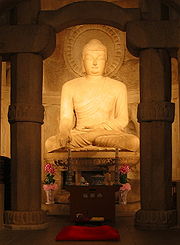
Bulguksa
Bulguksa is a head temple of the Jogye Order of Korean Buddhism in the North Gyeongsang province in South Korea. It is home to seven National treasures of South Korea, including Dabotap and Seokgatap stone pagodas, Cheongun-gyo , and two gilt-bronze statues of Buddha. The temple is classified as...
is also known as the temple of the Buddha Land and home of the Seokguram Grotto. The temple was constructed in 751 and consists of a great number of halls. There are two pagodas placed in the temple.
The Seokguram grotto is a hermitage of the Bulguksa temple. It is a granite sanctuary. In the main chamber a Buddha statue is seated. The temple and the grotto were added to the UNESCO
UNESCO
The United Nations Educational, Scientific and Cultural Organization is a specialized agency of the United Nations...
World Heritage list in 1995.
Tripitaka Koreana and Haeinsa
Haeinsa is a large temple in the South Gyeongsang province. It was originally built in 802 and home to the Tripitaka KoreanaTripitaka Koreana
The Tripitaka Koreana or Palman Daejanggyeong is a Korean collection of the Tripitaka , carved onto 81,258 wooden printing blocks in the 13th century...
wood blocks, the oldest Buddhist wooden manuscripts in the world. The carving of these wood blocks was initiated in 1236 and completed in 1251. The wood blocks are testimony to the pious devotion of king and his people.
The word Tripitaka
Tripiṭaka
' is a traditional term used by various Buddhist sects to describe their various canons of scriptures. As the name suggests, a traditionally contains three "baskets" of teachings: a , a and an .-The three categories:Tripitaka is the three main categories of texts that make up the...
is Sanskrit
Sanskrit
Sanskrit , is a historical Indo-Aryan language and the primary liturgical language of Hinduism, Jainism and Buddhism.Buddhism: besides Pali, see Buddhist Hybrid Sanskrit Today, it is listed as one of the 22 scheduled languages of India and is an official language of the state of Uttarakhand...
and stands for three baskets, referring to the Buddhist
Buddhism
Buddhism is a religion and philosophy encompassing a variety of traditions, beliefs and practices, largely based on teachings attributed to Siddhartha Gautama, commonly known as the Buddha . The Buddha lived and taught in the northeastern Indian subcontinent some time between the 6th and 4th...
laws of aesthetics. The Tripitaka Koreana consists of 81'258 wood blocks and is the largest, oldest, and most complete collection of Buddhist scripts. Amazingly there is no trace of errata or omission on any of the wood blocks. The Tripitaka Koreana is widely considered as the most beautiful and accurate Buddhist
Buddhism
Buddhism is a religion and philosophy encompassing a variety of traditions, beliefs and practices, largely based on teachings attributed to Siddhartha Gautama, commonly known as the Buddha . The Buddha lived and taught in the northeastern Indian subcontinent some time between the 6th and 4th...
canon carved in Hanja
Hanja
Hanja is the Korean name for the Chinese characters hanzi. More specifically, it refers to those Chinese characters borrowed from Chinese and incorporated into the Korean language with Korean pronunciation...
.
The site was added to the UNESCO
UNESCO
The United Nations Educational, Scientific and Cultural Organization is a specialized agency of the United Nations...
World Heritage list in 1995.
Hwaseong
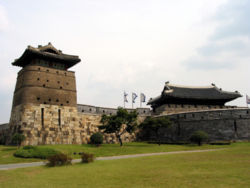
Hwaseong Fortress
Hwaseong , the wall surrounding the centre of Suwon, the provincial capital of Gyeonggi-do, South Korea, was built in the late 18th century by King Jeongjo of the Joseon Dynasty to honour and house the remains of his father Prince Sado, who had been murdered by being locked alive inside a rice...
is the fortification of the city Suwon
Suwon
Suwon is the provincial capital of Gyeonggi-do, South Korea. A major city of over a million inhabitants, Suwon lies approximately south of Seoul. It is traditionally known as "The City of Filial Piety"....
south of Seoul
Seoul
Seoul , officially the Seoul Special City, is the capital and largest metropolis of South Korea. A megacity with a population of over 10 million, it is the largest city proper in the OECD developed world...
in South Korea
South Korea
The Republic of Korea , , is a sovereign state in East Asia, located on the southern portion of the Korean Peninsula. It is neighbored by the People's Republic of China to the west, Japan to the east, North Korea to the north, and the East China Sea and Republic of China to the south...
. Its construction was completed in 1796 and it features all the latest features of Korean fortification known at the time. The fortress also contains a magnificent palace used for the King's visit to his father's tomb near the city.
The fortress covers both flat land and hilly terrain, something rarely seen in East Asia
East Asia
East Asia or Eastern Asia is a subregion of Asia that can be defined in either geographical or cultural terms...
. The walls are 5.52 kilometres long and there are 41 extant facilities along the perimeter. These include four cardinal gates, a floodgate
Floodgate
Floodgates are adjustable gates used to control water flow in flood barriers, reservoir, river, stream, or levee systems. They may be designed to set spillway crest heights in dams, to adjust flow rates in sluices and canals, or they may be designed to stop water flow entirely as part of a levee or...
, four secret gates and a beacon tower.
Hwaseong was added to the UNESCO
UNESCO
The United Nations Educational, Scientific and Cultural Organization is a specialized agency of the United Nations...
World Heritage list in 1997.
Gochang, Hwasun and Ganghwa sites
The sites of Gochang, Hwasun and Ganghwa were added to the UNESCOUNESCO
The United Nations Educational, Scientific and Cultural Organization is a specialized agency of the United Nations...
list of World Heritage in 2000. These sites are home to prehistoric graveyards which contain hundreds of different megalith
Megalith
A megalith is a large stone that has been used to construct a structure or monument, either alone or together with other stones. Megalithic describes structures made of such large stones, utilizing an interlocking system without the use of mortar or cement.The word 'megalith' comes from the Ancient...
s. These megaliths are gravestone
Headstone
A headstone, tombstone, or gravestone is a marker, usually stone, that is placed over a grave. In most cases they have the deceased's name, date of birth, and date of death inscribed on them, along with a personal message, or prayer.- Use :...
s which were created in the 1st century B.C. out of large blocks of rock
Rock (geology)
In geology, rock or stone is a naturally occurring solid aggregate of minerals and/or mineraloids.The Earth's outer solid layer, the lithosphere, is made of rock. In general rocks are of three types, namely, igneous, sedimentary, and metamorphic...
. Megaliths can be found around the globe, but nowhere in such a concentration as in the sites of Gochang, Hwasun and Ganghwa.
Gyeongju Area
The historic area around GyeongjuGyeongju
Gyeongju is a coastal city in the far southeastern corner of North Gyeongsang province in South Korea. It is the second largest city by area in the province after Andong, covering with a population of 269,343 people according to the 2008 census. Gyeongju is southeast of Seoul, and east of the...
was added to the UNESCO
UNESCO
The United Nations Educational, Scientific and Cultural Organization is a specialized agency of the United Nations...
list of World Heritage in 2000. Gyongju was the capital of the Silla
Silla
Silla was one of the Three Kingdoms of Korea, and one of the longest sustained dynasties in...
kingdom. The tombs of the Silla rulers can still be found in the centre of the city. These tombs took the shape of rock chambers buried in an earthen hill, sometimes likened with the pyramid
Pyramid
A pyramid is a structure whose outer surfaces are triangular and converge at a single point. The base of a pyramid can be trilateral, quadrilateral, or any polygon shape, meaning that a pyramid has at least three triangular surfaces...
s. The area around Gyeongju, in particular on the Namsan
Namsan (Gyeongju)
Namsan is a 494-meter peak in the heart of Gyeongju National Park, just south of Gyeongju, South Korea. The mountain is within easy reach from the city and attracts a large number of national tourists. Namsan covers an area of about 8 km by 12 km...
mountain, is scattered with hundreds of remains from the Silla period. Poseokjeong
Poseokjeong
The Poseokjeong site near Namsan in Gyeongju, Gyeongsangbuk-do South Korea, was built in the Silla period. The site once featured a royal pavilion–said to have been the most beautiful royal villa of the time—, but the only remains today is a granite water feature. This abalone-shaped watercourse...
is one of the most famous of these sites, but there is a great number of Korean Buddhist
Korean Buddhism
Korean Buddhism is distinguished from other forms of Buddhism by its attempt to resolve what it sees as inconsistencies in Mahayana Buddhism. Early Korean monks believed that the traditions they received from foreign countries were internally inconsistent. To address this, they developed a new...
art, sculptures, reliefs, pagoda
Pagoda
A pagoda is the general term in the English language for a tiered tower with multiple eaves common in Nepal, India, China, Japan, Korea, Vietnam and other parts of Asia. Some pagodas are used as Taoist houses of worship. Most pagodas were built to have a religious function, most commonly Buddhist,...
s and remains of temple
Temple
A temple is a structure reserved for religious or spiritual activities, such as prayer and sacrifice, or analogous rites. A templum constituted a sacred precinct as defined by a priest, or augur. It has the same root as the word "template," a plan in preparation of the building that was marked out...
s and palace
Palace
A palace is a grand residence, especially a royal residence or the home of a head of state or some other high-ranking dignitary, such as a bishop or archbishop. The word itself is derived from the Latin name Palātium, for Palatine Hill, one of the seven hills in Rome. In many parts of Europe, the...
s mostly built in the 7th and 10th century.
Complex of Goguryeo Tombs
The Complex of Goguryeo TombsComplex of Goguryeo Tombs
The Complex of Goguryeo Tombs lie in North Korea. In July 2004, they became the first UNESCO World Heritage site in the country. The site consists of 30 individual tombs from the later Goguryeo kingdom, one of Three Kingdoms of Korea, located in the cities of P'yŏngyang and Namp'o...
lies in Pyongyang
Pyongyang
Pyongyang is the capital of the Democratic People's Republic of Korea, commonly known as North Korea, and the largest city in the country. Pyongyang is located on the Taedong River and, according to preliminary results from the 2008 population census, has a population of 3,255,388. The city was...
, Pyong'an South Province, and Nampo City, South Hwanghae Province, North Korea
North Korea
The Democratic People’s Republic of Korea , , is a country in East Asia, occupying the northern half of the Korean Peninsula. Its capital and largest city is Pyongyang. The Korean Demilitarized Zone serves as the buffer zone between North Korea and South Korea...
. In July 2004 it became the first UNESCO
UNESCO
The United Nations Educational, Scientific and Cultural Organization is a specialized agency of the United Nations...
World Heritage site north of the 38th parallel.
The site consists of 63 individual tombs from the later Goguryeo
Goguryeo
Goguryeo or Koguryŏ was an ancient Korean kingdom located in present day northern and central parts of the Korean Peninsula, southern Manchuria, and southern Russian Maritime province....
, one of the Three Kingdoms of Korea
Three Kingdoms of Korea
The Three Kingdoms of Korea refer to the ancient Korean kingdoms of Goguryeo, Baekje and Silla, which dominated the Korean peninsula and parts of Manchuria for much of the 1st millennium...
. It was founded around northern Korea and Manchuria
Manchuria
Manchuria is a historical name given to a large geographic region in northeast Asia. Depending on the definition of its extent, Manchuria usually falls entirely within the People's Republic of China, or is sometimes divided between China and Russia. The region is commonly referred to as Northeast...
around 32 BC, and the capital was moved to Pyongyang in 427. This kingdom dominated the region between the 5th and 7th century AD.
Historic Villages of Korea: Hahoe and Yangdong
See also
- Korean birthday celebrationsKorean Birthday CelebrationsKorean birthday celebrations are an important part of Korean culture. When a person reaches an important age in his or her life, Koreans have unique celebrations to mark these milestones.- Dol :...
- Science and technology in KoreaScience and technology in KoreaLike most other regions in the world, science and technology in Korea has experienced periods of intense growth as well as long periods of stagnation....
- List of Korean inventions
- List of Korea-related topics
- National Treasures of South KoreaNational treasures of South KoreaThe National Treasures of Korea are a numbered set of tangible treasures, artifacts, sites, and buildings which are recognized by South Korea as having exceptional artistic, cultural and historical value...
- UNESCO World Heritage sites
- Traditional Korean thoughtTraditional Korean thoughtTraditional Korean thought has been influenced by a number of religious and philosophical thought-systems over the years. As the main influences on life in Korea, often Korean Shamanism, Buddhism, and Confucianism. These movements have shaped Korean life and thought...
- East Asian age reckoningEast Asian age reckoningEast Asian age reckoning is a concept and practice that originated in China and is widely used by other cultures in East Asia, which share this traditional way of counting a person's age. Newborns start at one year old, and each passing of a Lunar New Year, rather than the birthday, adds one year...
- Marriage in South KoreaMarriage in South KoreaMarriage in South Korea is similar to that in the West, but has unique features of its own, especially due to the influence of Korean Confucianism.-Eligibility:Marriage in South Korea is a union between a man and a woman...
- KkoktuKkoktuKkoktu are Korean funerary figures that protect, serve and care for the deceased in the immediate afterlife. They come in a procession that comprises a leading Guardian figure, followed by a Caregiver and an Entertainer. Figures of Dragons and Phoenixes are also common as symbols of freedom and...
External links
- Korean Fashion
- Trendy clothes
- Vietnamese Fashion
- Korea Society Podcast: The Origins of Koreans and Their Culture - Part I
- Korea Society Podcast: The Origins of Koreans and Their Culture - Part II
- Online gallery specialized on introducing North Korean artists
- Early photographs project showing public scenes, behavior, buildings 1895-1930
- Brief Explanation of Korean Customs (general customs, respect, marriage, dining)

